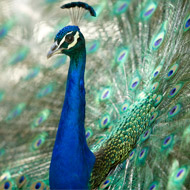
Researchers find dazzling colour prevents bees from seeing shapes
Iridescence in animals produces visual signals which may confuse potential predators, according to new research. Scientists say their findings, published in the journal Scientific Reports, could explain why iridescence is so common in nature.
Iridescence is where the colour of certain surfaces appear to change depending on the angle of illumination. The phenomenon can be seen throughout the natural world - from the dazzling blues of peacocks to the gem-like appearance of beetles.
Since its discovery over 100 years ago, iridescence has been assumed to be a way to attract mates and a way of displaying to other individuals. But in a first-of-its-kind study, led by the University of Bristol, researchers conclude that it can also be used to dazzle potential predators.
In the study, researchers presented bumblebees with different types of artificial flower targets rewarded with sugar water. The bees learned to recognise which shapes contained the sweet treat.
When the scientists presented the bees with iridescent flower targets, however, the bees found it much more difficult to distinguish between them.
“It’s the first solid evidence we have that thus type of colouration can be used in this way,” explained lead author Dr Karin Kjernsmo. “Thus, if you are a visual predator searching for the specific shape of a beetle (or other prey animal), iridescence makes it difficult for predators to identify them as something edible.”
She added: “This study has wider implications for how we understand animal vision and camouflage – now when we see these shiny beetles we can know that their amazing colours have many more functions than previously thought.”



 The RCVS has announced a new version of its 1CPD mobile app, with enhanced features for veterinary surgeons and veterinary nurses to record their continuing professional development.
The RCVS has announced a new version of its 1CPD mobile app, with enhanced features for veterinary surgeons and veterinary nurses to record their continuing professional development.